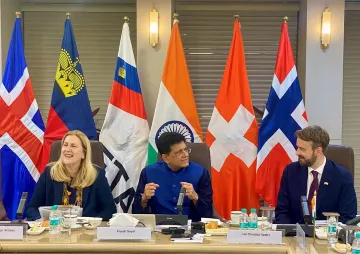 This is the sixty eighth part in the series
This is the sixty eighth part in the series The China Chronicles.
Read all the articles here.
A dichotomy exists between Beijing’s unilateral endeavour to create China-centered economic and financial dispensations, and its expanding engagement in multilateral economic governance.
The Belt and Road Initiative (BRI) is a unilateral initiative that is largely being executed bilaterally in 76 countries to date. At the same time, during the Belt and Road Forum last May, six multilateral development banks signed an MoU to support the BRI at the invitation of the Chinese president Xi Jinping. Furthermore, the China-led regional Asian Infrastructure Investment Bank (AIIB), currently 87-member strong with 24 non-regional members that include all but two G7 member countries, has approved 31 infrastructure development projects in 18 countries worth $6.3 billion in its 2.5 years of operation. This is beyond the larger role China is playing at existing international economic institutions, such as the World Bank.
The dichotomy has largely been addressed by evaluating the convergence between the bilateral BRI and multilateral AIIB in the context of the promotion of narrower Chinese interests — the two major policy actions were announced at the same time by the same Chinese leadership, heralding a “new era” of Chinese power as these initiatives seek to fulfil the “Chinese Dream.” Contrary to the initial coupling of the two, however, the AIIB, in its third year of operation now, reflects Chinese power, but not necessarily control, given how multilateralism — specifically the involvement of non-regional developed countries with first-mover experience — has shaped the bank’s setup, orientation, and functioning.
Moreover, five years down the line, BRI’s initial heyday is giving way to mounting challenges. One estimate pegs as many as 14% of BRI projects in terms of number and 32% in terms of value that have run into some or the other kind of “trouble.” There is local pushback, now being vocalised at the highest levels in key BRI participating countries like Malaysia and Pakistan, over a unilateral decision-making process that is resulting in financially unsustainable projects and a visible lack of local industry and workforce participation. Performance delays are being witnessed due to paperwork gaps, cost overruns, and laborious land acquisition; and the pressures of Chinese domestic economy, on top of risks being faced in underdeveloped countries, have seen Beijing decelerate investment outlays into the initiative.
China’s BRI needs to shape up or ship out. This reality engenders a new question: can the linkages between the BRI and multilateral development banks (MDBs) help future BRI progress? There are three specific ways in which the World Bank and AIIB could not only help sustain BRI activity, but also, importantly, help the BRI course-correct.
As the US, Europe, India, and Japan bring other connectivity and development finance options to the table, China’s BRI needs to shape up or ship out. This reality engenders a new question: can the linkages between the BRI and multilateral development banks (MDBs) help future BRI progress?
The following are three specific ways in which the World Bank and AIIB could not only help sustain BRI activity, but also, importantly, help the BRI course-correct. Shortcomings notwithstanding, the World Bank commands knowledge, extensive experience, substantial resources, and convening power that can prove useful for China in advancing the BRI, particularly given the bank’s renewed stress on scaling up infrastructure finance. The AIIB’s potential to help meet an ever-increasing demand for sustainable infrastructure that is most concentrated in emerging markets and developing countries could likewise be a springboard for a continued pursuit of the BRI and improved project implementation.
MDBs as springboards
First, the geographic overlap of projects under the World Bank, the AIIB, and the BRI can be to the advantage of the megaregional connectivity project. The World Bank has several projects in BRI participating countries related to connectivity, trade, and infrastructure worth over $80 billion. For instance, it funded the Kazakhstan stretch of the Western Europe-Western China Highway, a springboard for BRI’s trans-continental central corridor. More concertedly, the MoU signed with the World Bank could allow China to engage with the Bank in other countries to pursue its BRI, and, more broadly, to promote stable development in the many low-income countries across Africa and Eurasia that are on the BRI map. China has increased capital contributions as its status evolves from that of a borrower to a lender, which enhances its capacity to help direct World Bank resources. Strengthened domestic institutions and capacities can only improve the terms of engagement between recipient countries and the world’s largest infrastructure financier.
The AIIB’s narrower geographic reach and specific focus — mobilising infrastructure finance in Asia-Pacific — converges to a greater degree with the BRI’s primary mandate of building the hardware of economic connectivity to strengthen trade and investment across Asia, Europe, and Africa. “There is naturally going to be overlaps with the investments we make,” observed a senior official in the AIIB, with AIIB investments “assisting” many BRI projects. While the AIIB has so far not funded any explicit projects under the BRI, a third of its initial $3.5 billion loaned is BRI-related in that the transportation and shipping projects serve the purpose of infrastructure connectivity and thus “complement the BRI’s global network.” In fact, the AIIB has adopted “cross-country connectivity” as one of its three thematic priorities during the second annual meeting. The share of AIIB lending to cross-border physical infrastructure is therefore likely to remain significant, which the BRI can tap into — although such lending will remain focused on “bread and butter” BRI projects and stay away from any BRI geopolitically sensitive undertakings given the multilateral nature of the China-led bank.
The World Bank has several infrastructure and connectivity projects in BRI participating countries, which can act as springboards for BRI activity. The MoU signed with the World Bank will allow China to pursue more direct engagement, including the promotion of stable development in the many low-income countries across Africa and Eurasia that are on the BRI map.
MDBs as sources of expertise and experience
Second, the World Bank’s analytical and advisory expertise, and the AIIB’s modus operandi can help resuscitate lending into the BRI — albeit lending that is financially responsible and commercially viable.
The World Bank, an established player in the development finance space, can share knowledge and practices on technical issues like standards, financial instruments, and project preparation. Importantly, it can prove particularly useful in providing background information — such as country assessments. Critical gaps in China’s risk assessments and project design could therefore be plugged, and margin for inefficiencies narrowed.
These gaps have led to poor governance of BRI projects given a lack of attention towards local risks and conditions. Chinese companies are “going out” through the BRI to gain international experience, learn quality and management techniques, and adopt best practices to become global brands. Yet near 60% of Chinese companies present in BRI countries last year had no record of corporate social responsibility or sustainability reports. This is in face of concerns about environmental and ecological pressures (e.g., the $4 billion Ituango dam in Colombia that China helped finance is in danger of collapsing), lack of transparency and instances of corruption (e.g., investigation of links between Chinese loans and state fund 1MDB), and worsening socio-economic divides (e.g., land acquisition in Myanmar to create an SEZ at Kyaukphyu, over which 20,000 people could lose their livelihood).
The World Bank is currently studying the economics of the BRI to “quantify the potential benefits, identify critical infrastructure bottlenecks, and suggest solutions for policy and regulatory constraints.” The AIIB, “nested” as it is in the existing IFI and MDB system, boasts of human resources drawn from existing and established institutions, and is itself on a course to learn from the experiences of World Bank and other MDBs, and adopt best practices related to transparency, openness, accountability, and independence. Appreciably, AIIB is co-investing with other other MDBs in its projects: of the 24 projects for which it approved loans in its first two years, over half of them are co-financed. Notably, the AIIB is often not even the lead financier in its own projects, which means it will have to follow the external lender’s approach, and effectively adopt certain standards. China’s development banks can certainly lean on the access to expertise and processes learnt, which can also be passed on to its state-owned enterprises (SOEs). This would only strengthen plans of China’s policy banks to co-lend with western financial institutions in joint projects.
The AIIB's proximity to Beijing means the strong possibility of sharing practical means by which to operationalise principles of speed, cost-effectiveness, transparency, and sustainability enshrined in the AIIB’s dictum of “lean, clean and green.”
What AIIB brings to the table is its objective to improve functioning compared to legacy institutions. The bank’s proximity to Beijing means, again, the strong possibility of sharing practical means by which to operationalise principles of speed, cost-effectiveness, transparency, and sustainability enshrined in the AIIB’s dictum of “lean, clean and green.” China is often criticised for sacrificing quality for speed; the now eight-year-old, China-funded Hambantota port in Sri Lanka remains a poster child of Chinese white elephant projects.
Furthermore, the AIIB could be a happy medium to take notes from in terms of environmental and social safeguards (if these end up being different from the ones West-led financial institution advance), seeing as the World Bank has been found to be overly risk-averse, which has influenced policies towards borrowing countries.
MDBs as sources of finance
Third, the involvement of MDBs in key, viable BRI projects in key geographies as finance partners could help dilute the concerns that today follows a “China-funded” tag. Diversification of lenders can help “securitise the credit and syndicate the risk” in BRI projects, and could re-set the bar for BRI. Importantly, given rising concerns regarding China’s domestic economic health (think debt to GDP ratio that crossed 250% last year, of which a principal set of BRI actors — SOEs — own two-thirds), financing partnerships can ensure that the funding tap won’t dry up in defining BRI ventures.
MDBs can invest money — in a first such instance, the World Bank Group’s IFC is jointly investing with the Silk Road Fund into the “groundbreaking” Karot Hydropower Project, part of the China-Pakistan Economic Corridor. More importantly, they can mobilise other sources of funds for BRI projects given exposure to and experience in international markets and strong credit ratings. The World Bank’s MIGA, for instance, has provided guarantees worth $1 billion, which in turn has facilitated investment almost double this amount in BRI countries. The MoU, taken forward, could channel funds with more purpose.
This is not to suggest that the World Bank or AIIB can substantially supplement Chinese funding. The AIIB’s subscribed capital is half that of the World Bank Bank, and several AIIB projects are themselves co-financed with other MDBs. Moreover, China’s financing, led by China’s Exim Bank and the China Development Bank, far outstrips those of the top six western-led development banks, a list which includes the World Bank. Additionally, MDBs have not yet been successful in sufficiently attracting private sector participation in infrastructure — but this is not to say that the AIIB’s focus on catalysing private capital, as part of its broader ambition to innovate financial models, cannot prove instructive for Beijing to leverage its own domestic savings, for instance, as it proceeds with an inter-agency review of BRI deals. At the same time, the fact that China is supplying a huge demand in an area the World Bank has gradually shifted away from, and in weaker countries where international financial actors are averse to engaging but where such investments are most needed, means some natural complementarity exists — to minimise risks and maximise benefits — that can keep the BRI in the game.
The views expressed above belong to the author(s). ORF research and analyses now available on Telegram! Click here to access our curated content — blogs, longforms and interviews.



 This is the sixty eighth part in the series The China Chronicles.
Read all the articles
This is the sixty eighth part in the series The China Chronicles.
Read all the articles  PREV
PREV


